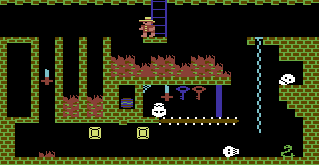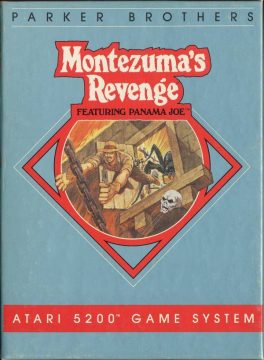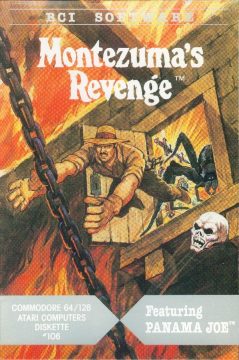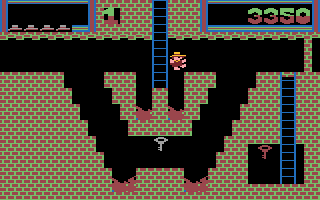- Montezuma’s Revenge
In the Golden Age of video games, there was no shortage of opportunities to explore the ruins of ancient civilizations. From Tutankham in the arcades to Aztec on the Apple II, raiding virtual tombs in exotic locations soon became a sport as popular as fending of space invasions or eating dots, thanks in no small parts to the success of Raiders of the Lost Ark in 1981. When reviewing the C64 title Fred, Electronic Games wrote in its March 1985 issue: “Tombs are getting almost as common in computer software as dot-lined mazes.”
Montezuma’s Revenge wasn’t the first to pair this setup with side-view arcade platforming action. It is preceded by both Pharaoh’s Curse and Spelunker (although that didn’t get widely known until the re-release by Brøderbund shortly after Montezuma’s debut). It also couldn’t really compete with the technical marvel of Spelunker‘s enormous multi-scrolling maze. But other than its forerunners, it was built on more systematic mechanics inherited from Donkey Kong, and is all the more playable for it.
Even though the game is named after a stomach condition, which refers to tourists not being able to deal with Mexican food, Montezuma’s Revenge takes the term literally and takes place in an Aztec tomb, although the Dio de los Muertos style skulls all over the place really are the only element where that shows. The Indiana Jones lookalike of choice this time is named Panama Joe. Parker Brothers was so proud of that name, they even put it in the title – the “featuring” byline should amusingly return twelve years later with Tomb Raider. Joe is controlled the same way as Jumpman/Mario in Nintendo’s genre-defining masterpiece, so his jumps have a fixed length that cannot be influenced in mid-air. He also doesn’t survive any falls that go down more than his own height, which often is very counter-intuitive for those who have grown up with Super Mario Bros., or anything that came later. Most of the stage props are also inspired by Donkey Kong: The rooms are made up of ladders, conveyor belts, and ropes (from Donkey Kong Jr.). New are platforms that phase in and out, usually above fiery pits that turn poor joe into a cloud of smoke if he falls into them. There are also a few poles he can only slide down, but not get back up again.
What really distinguishes Montezuma’s Revenge from Donkey Kong, though, is the fact that Panama Joe has to explore a giant pyramid that made up of up to 100 screens. Right from the very beginning, the hero is confronted with the choice between two locked doors, which both lead to a quite non-linear adventure. There are three different colors of doors, and of course they require appropriately colored keys (say hi, Doom). Joe can only carry five items at a time, though, and the space is shared with a number of other useful utensils. Oddly enough, it’s also not possible to pick up any more treasure when fully packed, even though the gems don’t actually use up inventory slots.
Just walking down empty halls would be boring, and the tomb of Montezuma holds some more active dangers than the traps. The aforementioned skulls come in rolling and jumping variants, and are the most basic enemy type. Spiders are more tricky, as they can follow Joe up or down the ladders. The snakes finally just sit around, but they have one dangerous advantage: When Panama Joe manages to get hold of a dagger, he can stab one enemy with it by touching it, but only the snakes are immune. At least the game is so fair as to remove any enemy after the hero collides with it once in the first few stages, so he doesn’t end up wasting all his lives on the same beast. Every once in a while, Joe can also find an amulet, which is used instantly and renders the creatures harmless for a few seconds.
While the whole pyramid is huge and confusing, the game starts out gently: Most of the right half is sealed off in the first stage, while the left half gets closed for the second. Only from the third stage onwards the player has to deal with the full 100 screen maze. Stage 4 adds more enemies and moves around a few items, but from then on all following stages are the same, with one exception: It gets darker and darker. From the very beginning, Joe has to find a torch if he wants to see anything (except enemies) on the lowermost floor. This darkness keeps creeping up with each stage, until the whole tomb is pitch black. From stage 5 onwards, it becomes essential to memorize the more dangerous rooms to survive. At the end of each stage awaits a time limited bonus round, where all Joe has to do is jumping around ropes to grab more treasure.
The whole process is iterated nine times (and the final variant repeated indefinitely), and that’s just about all there is to Montezuma’s Revenge – at least to the version Parker Brothers released for Atari computers. The game that the designer and programmer Robert Jaeger demoed earlier at CES (presumably Winter 1983 or Summer 1984) was very different. For starters, there is an animated title screen, followed by an intro introducing the hero, who used to be a sombrero-wearing Mexican named Pedro, before Parker Brothers jumped in to cash in on the Indiana Jones craze. The game suggests that there are multiple Pedros, who are shown waiting in line to get their turn whenever the player fails. Inside the game, the rooms are decorated with spiderwebs and painted pottery, adding to the Aztec tomb vibe of the game.
So much for the cosmetic changes, but Parker Brothers also took out a few gameplay elements. In the prototype, bats appeared on the screen to grab Pedro when he was lingering around certain rooms for too long, and some ropes started burning when a screen was entered, putting more time pressure on the player. But the biggest omission certainly was Montezuma himself, an immortal giant in the final room.
Apparently Parker Brothers wanted to keep the game at 16kb memory to make it fit on an Atari 5200 cartridge and didn’t want to bother creating two versions (which is odd because they ported the game to many platforms later). But the publisher also has to be credited with some significant improvements: In the original prototype, half of the pyramid was nothing but empty rooms, and there was only one correct path to the bottom. It was also ultimately incomplete: There was no way to defeat Montezuma, as Robert Jaeger couldn’t come up with a proper resolution. The final version, put together by Bob Halliday and Chase Sebor, offers a very different and more satisfying adventure, and Parker Brothers managed to form what was basically just a solid engine and a set of rooms into a challenging and exciting quest, Montezuma or no Montezuma.
A multiplatform publisher out-and-out, Parker Brothers did the usual porting spiel for most of the popular consoles and home computers at the time. While the Atari 5200 version was identical to the original, the game had to be stripped down for the older Atari 2600. The pyramid has only 24 rooms and the fire pits look like quicksand (with a cool palette rotation effect), but all the main elements are in there. It’s certainly one of the best among the few platforming games for the system. The final contemporary console version was for the ColecoVision, which aside from a brighter color palette and slightly lower resolution is also mostly the same as the original.
The home computer ports reintroduce the additional background elements from the prototype, but none of the more interesting elements. The Commodore 64 unsurprisingly does the best job, its only fault being Panama Joe’s walking sound effect, which sounds like someone is working an air-pump (although it wasn’t much better on Atari computers, it’s particularly annoying here). The Apple II and CGA IBM PC version suffer from the usual limited color palette and terrible controls. The IBM version also has timing issues and needs to be throttled down manually using DOSBox.
Somewhat later appeared a ZX Spectrum port for the UK, just named Panama Joe. This also has a downsized pyramid, but worse is the slow pace and the terrible hit detection – grabbing items out of the air requires pixel perfect positioning. It does hold one surprise, though: Montezuma is back. Although he looks really ugly here, and the way to get past him is a bit lame: He keeps stomping on the floor, causing Panama Joe to fall down a story, killing him unless he’s on the lower end of a ladder. All Joe has to do is wait on the ladder for the longer gap between two stomps and drop down a hole under Montezuma’s feet.
Five years after Montezuma’s Revenge was first published, Parker Brothers brought the game to the Master System. This version boasts eleven levels, although the later ones still only have minor differences in their layout. However, every tomb comes with a textual description, and until halfway through an additional hazard is introduced each time. The second and third stages reintroduce the Bats and burning ropes from the original prototype, and the fourth simply makes red keys extremely rare (which is annoying and can get Panama Joe stuck if he ever opens a wrong door by accident).
After that follow all-new elements: Tomb number five is inhabited by mummies, which are immune to all of Panama’s tricks and are also the only enemy who can move between rooms. This transition opens a short time window where they are present in neither room, though, which makes it possible to sneak past them. The sixth stage (the highest one that can be selected from the start), has rooms where a huge rock comes rolling at potential grave robbers, although this trap is not staged very well and doesn’t pose much of a problem. Stage number 7 finally ads a huge pit that spans multiple stories, and a parachute Joe can find to glide down safely. The final five tombs have descriptions of their masters that grow increasingly frightening, but they don’t actually mean anything. Sadly, no King Montezuma here, either.
The established mechanics have also changed a bit: Since the Master System controller offers two buttons, the amulet can now be saved for later and activated with the second button when needed. In dark rooms, ladders, ropes, conveyor belts and items are displayed alongside the traps and enemies, which makes it much easier to navigate without the torch. Curiously, the pause button on the system enables cheating: The disappearing floors and traps keep running their interval when paused, so it’s easy to just press pause just before Panama Joe loses the ground under his feet, and unpause once the floor is back. Finally, the bonus area at the end of each stage has been compressed into one single room, with spikes closing in from the floor and ceiling.
A major graphics update for the Master System was no surprise, and aside from a cutscene that shows the hero entering the pyramid before each stage, Parker Brothers have added a lot of different tiles and decorations for the walls. The backdrop is still pitch black, though. Unfortunately, no music during the game was added. From the old home computers it was to be expected to hear nothing but some bleepy sound effects and a short jingle whenever Joe picks up an item or gets an extra life. On the Master System, however, the silence is a bit of a disappointment.
When Montezuma’s Return was released in 1998, it contained the original Montezuma’s Revenge as a bonus. It was the very original version, the unfinished prototype with Pedro. That choice is not as odd as it might sound, giving the divided name rights between Jaeger (for Montezuma’s Revenge) and Parker Brothers (for Panama Joe). It is embedded in a custom emulator, which runs the game just fine, although it uses much more garish colors than modern emulators.
Montezuma’s Revenge was also flattered with two fan remakes for Windows. The first one, created by Bartosz Duzy in 2004, is modeled after the C64 version (with identical sound effects) but comes with new high resolution graphics. The second by Bad Mouse Digital Art was released in 2006 and takes more liberty, by transforming the game into 2.5D with adorable cartoon sprites and a less restrictive inventory system. Unfortunately, it is rather picky about the PCs it choses to run on.
In 2012, Rob Jaeger’s new company Normal Distribution published a remake for iOS devices. This features widescreen graphics and a rather questionable new look. But the game can also be switched to “Retro” mode. This doesn’t look exactly like the classic game, but rather bathes the pyramid in trippy pseudo-retro colors.
Links:
Digital Press – Interview with Robert Jaeger
Bad Mouse Digital Art Homepage for the 2006 fan remake.
Normal Distribution Homepage of Jaeger’s current company.
Comparison Screenshots





